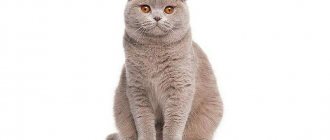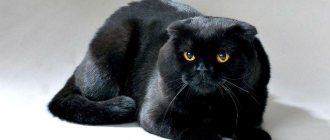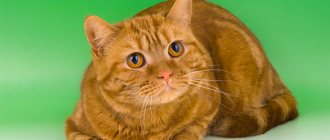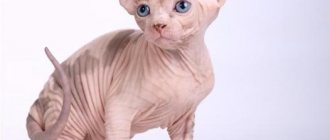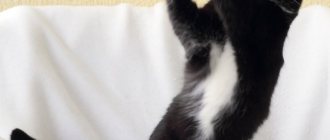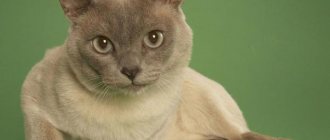At the beginning of the last century, England was the felinological center of Europe. Breed standards were drawn up here for the first time, the first cat show in world history was held, and 3/4 of the 170 animals announced for participation in it consisted of British shorthair cats. Among them they found a kitten with curled ears, which became the first representative of the new breed.
British Fold cats quickly gained popularity and took pride of place in the breed hierarchy. Subsequently, a standard was drawn up for them and their character, habits and health characteristics were studied in detail.
Brief history of the breed
Experts disagree on exactly when the British Fold appeared.
- The first version dates back to the time when the ancient Romans conquered Britain (around 43). Egyptian cats also came along with the invaders, who later adapted to the new climatic conditions.
- Another hypothesis mentions the Crusades - the warriors appreciated the useful abilities of the eastern rat catchers and brought them home.
- Cats infiltrated merchant ships that sailed between the Old Continent and Africa. There were always a lot of mice on ships, and the crew favored small animals that helped get rid of rodents.
What is known for certain is that the first British cats came to the European mainland from North Africa and the Middle East. Further formation of the breed took place under the influence of local conditions: the animals developed thicker hair and developed immunity against diseases common in the area.
Description of kittens
Newborn white British kittens sometimes have a colored patch that disappears after the first year. This is not a flaw and is acceptable for this breed. Cats are caring mothers and spend all their time with their kittens. After a week, the eyes open. Starting from the third week, kittens can begin to be fed liquid food. Little Britons quickly become plump. They grow up slowly. Females reach their prime by age five. They live up to 20 years.
Little kittens are very similar to teddy bears, energetic from birth. Difference from other breeds:
- the kitten has a strong body, a wide chest and strong legs;
- round head, plump cheeks, rounded straight ears, round eyes of marsh or bluish-gray color; by the age of one year, the shade of the eyes changes;
- the tail is plump, thick and rounded at the very tip;
- thick wool of equal length approximately 2 cm.
In order to determine the gender of the kitten, you need to lay it on its back and feel the place under the tail.
The color of kittens varies, the most common are solid colors: black, red, cream, blue, lilac and white. Adult cats with these colors have amber or orange eyes. And only a white Briton (photo below) can have different colored eyes.
At the age of two to four months, kittens are very mischievous and can misbehave.
Interesting facts about the British cat breed
Descriptions in ancient books and images in paintings indicate that the first British cats were not fold-eared:
- The Gospel from Lindisfarne (7th century) contains an image of a cat that is very similar to the modern Briton.
- The Book of Columba, a recognized handwritten masterpiece of the Irish monks, also contains illustrations of straight-eared cats.
You can read more about straight-eared Britons in this article.
Artists and sculptors depicted them to pay tribute to the beauty and grace of these animals. The monks wrote in poems that the life of hermits becomes more interesting and fun if a cat lives nearby. She was the only pet allowed to live on the grounds of nunneries.
This is interesting! England became the first country to pass a cat protection law. In 936, the English prince Howell Dda issued a decree prohibiting any violence against these animals.
Color of adult cats
British white cats are undoubtedly beautiful, but other shades look no less impressive.
Popular colors are:
- tortoiseshell;
- silver and golden shaded;
- patterned;
- plain and smoky;
- lilac;
- black.
These colors of British cats are truly fascinating.
Tortoiseshell tone
In this case, the coat should have an equal number of tones, and there should be spots on the face. Only cats are tortoiseshells. Beauties can boast a combination of shades such as chocolate/black/brown along with cream/red, as well as lilac/blue. Breeders rarely manage to obtain a tortoiseshell shade.
Silver and golden shaded
The main color can be seen on the back, head, tail and ears. As for the chest, belly, paws and collar, light gray predominates on these parts, which is similar to lilac.
Patterned or tabby
British tabbies can have a variety of body patterns such as leopard spots, distinctive stripes and large markings. At the base of the head, the fur may have a completely different shade - this is the norm. Pictured Britons are divided into many subspecies.
Plain and smoky
Monochromatic cats are those whose coat, including the undercoat, has the same tone. If there is at least one small inclusion, then the animal cannot be called monochromatic. Smoky beauties have a slightly lighter undercoat, due to which the color of their coat “plays” in the sun.
Lilac color
The fur of young kittens resembles a pink color, which transforms with age and becomes light purple. Only the undercoat differs in animals, which has a much lighter shade. As for the eyes of such kittens, they are copper or orange. It is very difficult to get a purple coat color - you need real luck.
Black color
Not only the coat and undercoat have a black (charcoal) tint, but also the skin. This color is rare, but only because kittens that are born charcoal may turn brown or chocolate as they age.
There are many rare colors that are rarely seen. So, there are Britons with dark markings, but the main color can be gray or brown. Many people like such “mixes,” but, unfortunately, “ordering” them is problematic.
Description of the British Fold breed: standards, appearance and character of the cat
The breed standard details the characteristics required for the breeding of the British Fold cat.
Dimensions and weight
A strong, medium-sized cat with a dense build. Newborn British Fold kittens weigh from 70 to 130 g. In the first week, body weight increases 1.5 times. Further indicators will depend on the gender of the pet - boys gain weight faster, and girls are traditionally more petite and graceful.
The average weight of an adult British cat is 8 kg, and female cats are usually 2-2.5 kg less. The average height of an animal is 28-35 cm, with cats being approximately 5 cm taller than female cats.
Important! One of the peculiarities of the breed is that the British reach puberty at 2 years of age, but they gain weight before the age of 5.
Anatomical characteristics of the British Fold - what a cat of this breed looks like
British fold cats can be divided into three groups:
- Traditional British Shorthair. The auricles are small, with a slight rounding at the apex. The coat is thick and shiny. Powerful and flexible tail of medium length.
- Long-haired cat. Breeders crossed the British with other breeds (Persians or representatives of the Somali branch) in order to obtain new colors. But in addition to color, the animals inherited long hair from their parents. Such kittens were first culled, and later interbreeding was prohibited. But the population of mestizos increased and was subsequently officially recognized by felinologists as the British longhair cat.
- Fold-eared Briton. A cat with short, thick hair and ears that curve forward. The body is wide, the paws are low. Some international felinological organizations do not officially recognize the breed because they consider lop ears to be a defect that was caused by a gene mutation.
This is interesting! All newborn kittens of this breed have straight ears, so it is impossible to immediately determine whether the pet will have fold ears.
British coat color and type
The Scottish (or British Fold) breed took from its parent branch a short, thick coat with a dense, elastic texture and a warm undercoat.
Traditional colors include:
- blue lop-eared British;
- gray fold cats;
- tabby tabby cats.
There are about 200 combinations of different colors in the colors of the British Fold cat breed, including the exotic acromelanic color point.
Possible breed defects
An uncontrolled mutation negatively affects the condition of skeletal bones, joints and spine in (Scottish) British fold cats. To counter the deterioration of the genotype, felinologists and breeders had to develop some rules that prevent the development of irreversible defects.
- When crossing, the union of two fold-eared parents is avoided. In a cat “marriage,” a British Fold is matched with a cat from a different breed—an American Shorthair or an exotic.
- Even as a result of mating with representatives of other breeds, offspring may be born that are predisposed to loss of tail flexibility due to fused vertebrae. For this reason, felinologists cull short-tailed British cats, which are more prone to developing this disease than others.
Geneticists were able to find out how this mutation affects the health of the British Fold cat. It turns out that negative consequences occur only in the presence of a homozygous form, when both acquired genes are present in the same paired state.
Alleles that scientists have already studied are responsible for lop ears. In the FdFd variant, they lead to irreversible consequences, and the Fdfd combination is completely safe for the health of the British Fold cat.
Important! If the cat has signs of lameness, and small kittens avoid active movements such as running and jumping, this is a signal of the presence of a congenital disease.
Origin of white color
The British white cat is a species with clean, spotless fur. Such British women are also called solid white. For a uniform, uniform coat of rich color from the tip of the ears to the tail. This is clearly visible in the photo with white British cats.
White British cats and female cats receive close attention at international felinological exhibitions and are awarded the highest scores of up to 25 points for coat color. The British value bright color, distributed evenly, without nuances, without tinting yellowness or inclusions. The following are considered permissible: nose mirror, eyelids, paw pads only pink.
Offspring with snowy fur are obtained in the following cases:
- Recessive variant, with the gene (c/c or ca/ca), albino.
- The (S) gene dominates indefinitely; the cat is not always white.
- The gene without color (W) is dominant in kittens.
Undoubtedly, the white British cat looks attractive in the photo. This color is popular, although not very common due to difficulties and problems with breeding. When crossing two white parents with dominant genes (W/W), the same kittens appear, but suffering from serious defects, such as:
- deafness, complete or partial;
- decreased or loss of sense of smell;
- partial blindness;
- not achieving absolutely color.
In 1997, at the council of the felinological symposium, it was decided to ban the selection and breeding of white British cats, with the likelihood of giving birth to kittens with severe anomalies.
Eye color
The British white cat has three types of eye colors:
- sapphire blue,
- gold or copper (orange)
- Odd-eyed white eyes
In cats with heterochrony (different eyes), combinations are possible:
- green and golden;
- blue and green;
- blue and gold.
Breeders have noticed that white cats with blue eyes are often born deaf due to genetic problems, but there are rare exceptions of a kitten appearing without a defect. In cats with one blue eye and one green eye, the level of vision often decreases and deafness appears.
The character and temperament of the British (how they treat children, do they get along with other animals)
The habits of the British Fold cat and its character do not at all correspond to the parent breed:
- The behavior of the British cat is balanced; it does not show aggression towards others.
- A distinctive character trait of the British Fold is devotion to the owner and other family members.
- Despite their sociability, representatives of this breed can easily tolerate loneliness.
- British cats get along well with children and enjoy taking part in general games, but do not like to be treated roughly.
Who is better to choose
It is difficult to say which breed is better, British or Scottish. The choice of a pet is based on the preferences of the future owner, daily routine and rhythm of life. The British cat quickly becomes attached to the house and considers himself a full member of the family. He likes to be left alone for a long time, but a purebred animal needs proper care and timely education.
The British man’s appearance is brutal, his behavior is very important. It is no coincidence that previously only the rich segments of the population could afford to keep such cats.
The facial expressions of pets are interesting and funny. Up to a year old, babies are playful and active, but closer to the age of two, the cat’s habits change, she becomes calm and sleepy. The baby loves to sleep, lounging on the plush back.
The Scottish cat, as a kitten and as an adult, is playful and noisy. He will run around at night or run around the apartment with a rubber mouse.
The Scottish woman loves children, she likes the attention of the owner and family members. Everything in it is for a large and noisy company:
- A funny pose in which your pet often sits: on its tail, with its long legs outstretched.
- Or the famous gopher stand, when the baby stretches vertically on its hind legs, tucking its front legs.
- Ability to walk on a leash and follow various commands.
This cat combines the qualities of cats and dogs. Caring for a cat is not difficult. The Scottish favorite cannot stand heights: flying from the top shelves is not possible for the animal due to the structure of its limbs.
How to distinguish a British kitten from a Scottish one
The difference between British and Scottish cats is obvious. It makes no sense for nursery owners to deceive those who want to buy babies of a certain breed.
The smaller the kitten, the more difficult it is to distinguish a British cat from a Scottish pet. Characteristic signs appear as the baby grows older. Therefore, it is better to buy a baby at the age of 2-3 months.
By this time, the Scotchfold ears, straight from birth, will acquire the desired fold. The eye color will gradually begin to acquire a constant shade that matches the color of the animal's coat. A mandatory item when choosing a kitten is to check the baby's tail: for a fold-eared baby, it should be long and mobile. The British have a powerful, thick tail, much shorter than that of the Scot.
The main points of difference between kittens of the British and Scottish breeds, which people pay attention to when choosing babies:
| British kittens | Scottish kittens |
| Heavier paws, clubfoot when walking | Long light limbs |
| Chubby cheeks | Cheekbones are not very pronounced |
| Large baby | Small in size |
| Round head | Elongated skull shape |
Babies do not differ much in their habits: up to a year old, representatives of these breeds are active and respond to play with pleasure. The difference in behavior between the British and Scottish cats will be noticeable in later life.
To the touch, the Scottish have fur that is more fluffy and soft, gliding, while the British have dense and thick fur. An inexperienced buyer will not be able to independently determine what breed the cub belongs to. The difference in behavior between the British and Scottish cats will be noticeable in later life.
Leave the content of the British
British cats are short-haired, so they are brushed at least once a week, and every other day during heavy shedding. To care for the fur, use standard “cat” combs or special gloves, which can be purchased at a pet store.
The presence of slight discharge from the eyes and nose is normal for the British Fold cat. The owner needs to regularly carry out hygiene procedures - clean the nose and eye area from dirt.
Particular attention should be paid to cleaning the ears of a British Fold cat. The unusual structure of the shell complicates the procedure, so you need to act very carefully so as not to harm your pet.
- First, the bent tip of the ear is bent and access to the inside is freed.
- Using a cotton swab, carefully clean the areas that are in your field of vision.
- For deeper cleaning, use special ear drops or other preventive liquid preparations that can be injected into the ear canal.
Unusual cat behavior is a cause for concern. If your pet shakes its head or there is an unpleasant odor coming from the ear, you should immediately seek help from a veterinarian.
Feeding a British Fold cat
The diet depends on the individual characteristics of the cat. The pet owner must choose one of three options:
- natural food;
- industrial feed;
- mixed feeding.
Practice shows that in real life all three points are used. During childhood, owners and breeders most often feed British Folds with homemade food and independently calculate the portion and calorie content.
Adult cats switch to dry kibble without any problems. And in old age, the animal happily eats both the first and the second.
Important! Representatives of this breed are prone to overeating and gaining excess weight. This is dangerous for the cat's health, since it has a genetic predisposition to diseases of the bones and joints.
How the British became related to the Scots
After fold-eared cats were banned in Europe, work with them continued in the USA. Due to the high mortality rate of kittens, Scottish Fold + Scottish Fold matings were also banned in America. Folds began to be crossed with the British Shorthair, Persian, and American Shorthair. The British and Scots were especially active in connecting with each other. They wanted to add new colors to the British, and to make the Scots with thicker fur and massive bones. From such matings, both fold-eared kittens and babies with normal ears were born, who were called straight. Animals with different hair lengths also appeared - Highland Fold (long-haired fold), Highland Straight (long-haired straight-eared). There are 4 varieties of Scottish cats.
Education and physical activity
Despite their sociability, the British are independent and willful. Therefore, when training and raising a pet, certain rules should be followed:
- You need to show your cat your dissatisfaction immediately after committing an offense.
- It is important to maintain consistency in the training process - for example, you should not allow your pet to sharpen its claws on the back of a chair today, and scold your pet for it tomorrow.
- Praise is very important for the British Fold - do not forget to reward the cat for positive actions.
Physical activity is one of the main indicators of an animal’s quality of life. It is necessary to provide the animal with sufficient space for play, prepare toys and be sure to engage with it.
Who is the white color suitable for?
It’s impossible not to fall in love with these snow-white beauties at first sight. As a rule, they look incomparable, are flexible with a friendly character. The British are loyal, affectionate, and the smartest creatures. Such cats are suitable for organized, wealthy people. Able to pay careful attention to the care of snow-white fur, to possible defects in pets, such as deafness, decreased vision. The owner will benefit from the exceptional features of the British White, such as:
- have medicinal properties, remove negative energy;
- are able to brighten up loneliness and become a wonderful friend;
- will begin to generate pride and general delight;
- are made mascots at home, especially pets with different eyes, bring happiness and good luck.
Vaccinations and antiparasitic treatments
A standard scheme for the prevention of internal and external parasites (endo- and ectoparasites) is applied to British cats.
Before a kitten goes to a new owner, the nursery must carry out deworming and flea treatment. In the future, preventive measures are carried out according to the following scheme:
For lop-eared Brits who don't go outside:
- Treatment against external parasites using drops or in combination with a special collar – once a month.
- Antihelminthic procedures are carried out once every 6 months, in the first week after treatment against ectoparasites.
Cats that go outside are dewormed and treated for external parasites 2 times more often.
Important! You can become infected with worms and fleas even in an apartment - the larvae are brought into the room with shoes or clothes.
Consequences of mating a Briton and a Fold
The Scottish Straight breed was officially recognized in 2004. Since that time, mating of British and Scottish Folds has become prohibited.
Mating a British cat and a Fold is an interbreed type of mating that blurs the standards of both breeds. As a result of such reproduction, outbred kittens appear that do not fit any standard.
Failure to meet standards is not that important. The main reason for banning such breeding is the health problems of mixed-breed kittens.
The fact is that these two breeds have different bones; the British have a heavier bone than the Folds. Also, due to a special gene mutation, the Scots have a weak structure of cartilage. Heavy bones and weak cartilage are passed on to the offspring, and this leads to serious musculoskeletal disorders.
The consequences of crossing a Briton and a Fold lead to gross genetic disorders in the offspring. Therefore, such matings are prohibited!
Sterilization and castration
In order not to deteriorate the breed, experts recommend spaying/castrating cats with minor or critical defects. Not everyone knows that sterilization and castration of animals are two different procedures, and cats are also castrated.
- Sterilization does not involve the removal of organs, but only limits their reproductive functions. It is considered more gentle and humane towards animals. However, after sterilization, the behavior of cats does not change. They still have a natural desire to mate, but are physically unable to produce offspring.
- Castration is carried out on both male and female cats. As a result of surgery, the testes (for males) and ovaries (for females) are removed. The production of sex hormones stops, reproductive function is absent.
Hidden dangers of surgical procedures exist, but such operations are always planned and have already become familiar to veterinarians.
Cost of kittens
Specialized nurseries have a fairly large selection of British dogs. The cost of a kitten depends on its color and class:
- Show. Elite kittens of this class are an example of the British breed. Their cost starts from 40 thousand rubles.
- Breed. Kittens of this class have subtle flaws. They are mainly bought as future breeders of offspring, since with the right pair they can easily produce top-class kittens. The price starts from 22 thousand rubles.
- Pet. The British of this class have significant shortcomings and do not meet the requirements of the breed standard, although they are very beautiful kittens. They are bought as pets and as an affectionate friend. Cost - from 6 thousand rubles.
In the range of 3 to 5 thousand rubles you can buy a pet without a pedigree.
All pets, and especially the British white, love their owners and especially need reciprocal feelings.
Pros and cons of the British cat breed
| Positive traits | Negative qualities |
| Unusual appearance | Tendency to genetic diseases |
| Sociability and loyalty to all family members | Ears require special care |
| Good learning ability | |
| Resistance to common diseases |
Experts believe that it is already possible to detect the presence of genetic diseases in a British Fold cat at the age of 3-5 months. In addition, conscientious breeders adhere to recommendations regarding mating in order to improve and strengthen the breed.
In such conditions, the risk of developing pathologies is reduced to a minimum, which means that the risk of acquiring a sick animal is significantly reduced. A healthy and cheerful fold-eared cat is always joy and good mood for its owner.
Purchasing a fold kitten
Although British Folds are for sale, do not forget that such a breed does not exist. By purchasing such a baby, you risk getting a mixed breed from a fold-eared cat. Of course, British Fold kittens will not have the necessary documents.
When choosing a pet, it is better to give preference to responsible breeders or nurseries who are concerned about the health of the offspring. In this case, prohibited mating options are excluded, and accordingly, kittens are born without genetic abnormalities.
When purchasing a Scottish Fold kitten, pay attention to the following factors:
- must not be less than 10 weeks old
- the kitten must have a veterinary passport with vaccinations
- It is recommended to inquire about the chronic diseases of parents
- At the age of 2 months, fold-eared kittens should be able to go to the litter box
- Fold ears drop on average on the 21st day of life, so it is not difficult to distinguish this breed when purchasing
The cost of a fold-eared kitten with documents starts from 5,000 rubles.
Health and vaccination
Fold-eared “Britons” are at risk for genetic pathologies. This is due to the fact that they are descendants of two closely related breeds, one of which carries the gene for lop ears. This gene not only makes the ears original, but can also cause serious pathologies of the skeleton and bone tissue.
IMPORTANT! In kittens born from two lop-eared individuals, osteochondrodysplasia is inevitable - an incurable deformation of the joints. Therefore, fold-eared pets are crossed only with straight-eared ones.
Fold-eared “British” dogs are also susceptible to:
- hearing loss;
- respiratory viral infections;
- claw fungus;
- helminthiasis;
- flea infestation;
- disruption of the heart;
- the appearance of renal cysts.
For preventive maintenance, your pet needs to be shown to a veterinarian annually and vaccinated. Each vaccine is administered according to the time limits established by the veterinarian. Vaccination helps protect your pet from panleukopenia, rabies, and respiratory infections.
A healthy and well-groomed British Fold cat lives about 15 years.
Health, reproduction, kittens
British Folds were created through crossbreeding, so they can be quite sickly.
In particular, they have a high risk of developing the following pathologies:
- Deformation of cartilage in some individuals affects not only the shape of the ears, but also the entire spine. Therefore, they may experience fusion of the vertebrae, shortening of bones and thickening of joints, and the appearance of bone growths, which can only be corrected surgically.
- Hypertrophic cardiomyopathy (HCM) is a genetically determined uneven thickening of the interventricular septum and ventricular walls. Progresses to heart failure with chest pain. The disease makes itself felt in individuals after a year and is detected by ultrasound.
- Obesity. Due to a good appetite, if you do not monitor your pet’s nutrition and activity, it can gain excess weight quite quickly. This in turn will lead to many health problems. A proper diet, outdoor games and plenty of space in the house or yard increases his activity and reduces the risk of illness.
- Worms, fleas and other parasites come from the outside, are absorbed with food or hairballs when licking, especially if the cat is in contact with other animals. Now there are many means to get rid of them, which are best used as prescribed by a veterinarian.
- Infectious diseases. These are immunodeficiency, aspergillosis with chronic runny nose, calcivirosis and rhinotracheitis. And especially life-threatening peritonitis, panleukopenia, leukemia, rabies, tuberculosis. To prevent them, vaccinations are necessary: annual against rabies starting from the age of 8 months, and others no later than the three-year period when maternal immunity is still in effect.
On average, adults live from 14 to 20 years if you monitor their condition.
For example, periodically lifting an animal by its front legs reduces the likelihood of developing spinal pathologies. Timely and proper care will avoid many other problems.
Particular attention should be paid to the issue of breeding pets. If owners want to get healthy offspring, under no circumstances should individuals with the same gene be crossed when both of them have drooping ears.
It is worth taking individuals with straight and curved ears, it is better if both of them belong to the British breed. And after 9 weeks it will be possible to get a mixed litter, but the likelihood of their mutation is significantly reduced.
We recommend reading: American Raccoon Cat: comparisons, features, facts
The peculiarity of lop-eared cats is that they are all born with erect ears. They acquire their shape only on the 21st day, then it will be clear which of the babies will be straight-eared and which will be a typical representative of the British breed.
The owners will only have to choose suitable nicknames, remembering that the British are proud and independent animals, and they will serve their family faithfully.
Pitfalls - hereditary diseases of the British
Unfortunately, when buying a kitten, you may encounter the development of hereditary diseases. Experienced breeders monitor the manifestations of each disease, eliminate the defective gene in a timely manner, achieving healthy offspring, which cannot be said about amateurs who cross a cat with a similar cat.
Illiterate mating between a British and a Scot can lead to various diseases in the offspring, even if the mother and father are completely healthy. The most common problem is improper formation of the skeleton. As a rule, these are deformations of the spine and toe bones.
Growths may form on the bones of the paws, it becomes difficult for the animal to walk, and it becomes lame. Help consists of surgery and removal of bone growths. In some cases, heart disease develops, which usually appears after a year. To diagnose the disease at the initial stage, it is worth conducting an ultrasound of the heart annually.
If you are lucky enough to acquire a healthy kitten, most likely it will have a typical British disposition. He will be calm, balanced, love sleep and food. In childhood, the animal may be naughty, but in the future it becomes more and more lazy.

